
In this blog post we discuss coatings for gas delivery systems and the importance of getting it right the first time.
SilcoTek Coatings for Pure Gas Delivery
The raw material supply chain has become ever-increasingly important in meeting global demand. But with recent supply issues, it has never been more important to assure products are built right the first time. That's where maximizing purity in product manufacturing specifically in process gas delivery systems is important.
|
In this blog post you will learn;
- The importance of getting high purity gas right the first time.
- How SilcoTek® coatings contribute to improving the purity of critical flow paths like gas delivery systems.
- Get coating performance data that demonstrates how high purity CVD silicon barrier coatings can improve your products.
|
Introduction and Background
Gas purity is important to minimizing product contamination, especially in sensitive analytical and electronics manufacturing applications. Yes it's always been important to maximize product yield but now it's not only important, it's critical to the survival to international supply chains and businesses. Operations need to minimize failures because bottlenecks can stretch the lead time for failure replacement to the point where customers look to other suppliers.
To assure the highest purity and minimize the potential for failures, manufacturers and analysts are looking to improve material purity wherever they can. That's where coating critical flow paths with high purity silicon makes sense. Especially in analytical and electronics manufacturing where the standards for purity in gas delivery are critical for successful manufacturing.

In modern production, purity can be difficult to achieve, especially where reactive metal surfaces like stainless steel are prevalent. Additionally, increasing cost and scarcity of more inert exotic alloys restricts the feasibility of their use to only the most critical processes. SilcoTek® coatings are the industry leaders for delivering a high purity metal-free surface while respecting the cost of manufacturing, creating a higher quality, longer-lasting end product.
Protecting Against Contamination
Product contamination can be at times insidious and difficult to detect. Particulate contamination can be managed and contamination relating to material compatibility or corrosion can also be relatively easy to detect and manage. But metal ion contamination can be much more difficult to detect and eliminate. Metal contamination can cause test errors or degrade quality in analytical systems and can severely impact product yield in electronics and semiconductor manufacturing. Metal contamination can be traced to stainless steel and other alloys but the chemicals involved may not be as obvious. Corrosive acids can surely cause contamination but deionized water and even methanol can also leach metals and cause contamination.

Here's an example of how exposure to common methanol can result in contamination. In this test, we used a solvent extraction technique and tested by ICP-MS to measure the degree of metal contamination in parts exposed to methanol. Parts were soaked in methanol for 30 days to allow for measurable metal extraction. Samples were then analyzed by mass spectroscopy to investigate metal ions present in solution.
This image (right) shows the amount (part per billion, PPB) of metal contamination found after soaking the samples in methanol for 30 days.
The Silcolloy-coated C-22 outperformed
the uncoated C-22 by 1000x. |
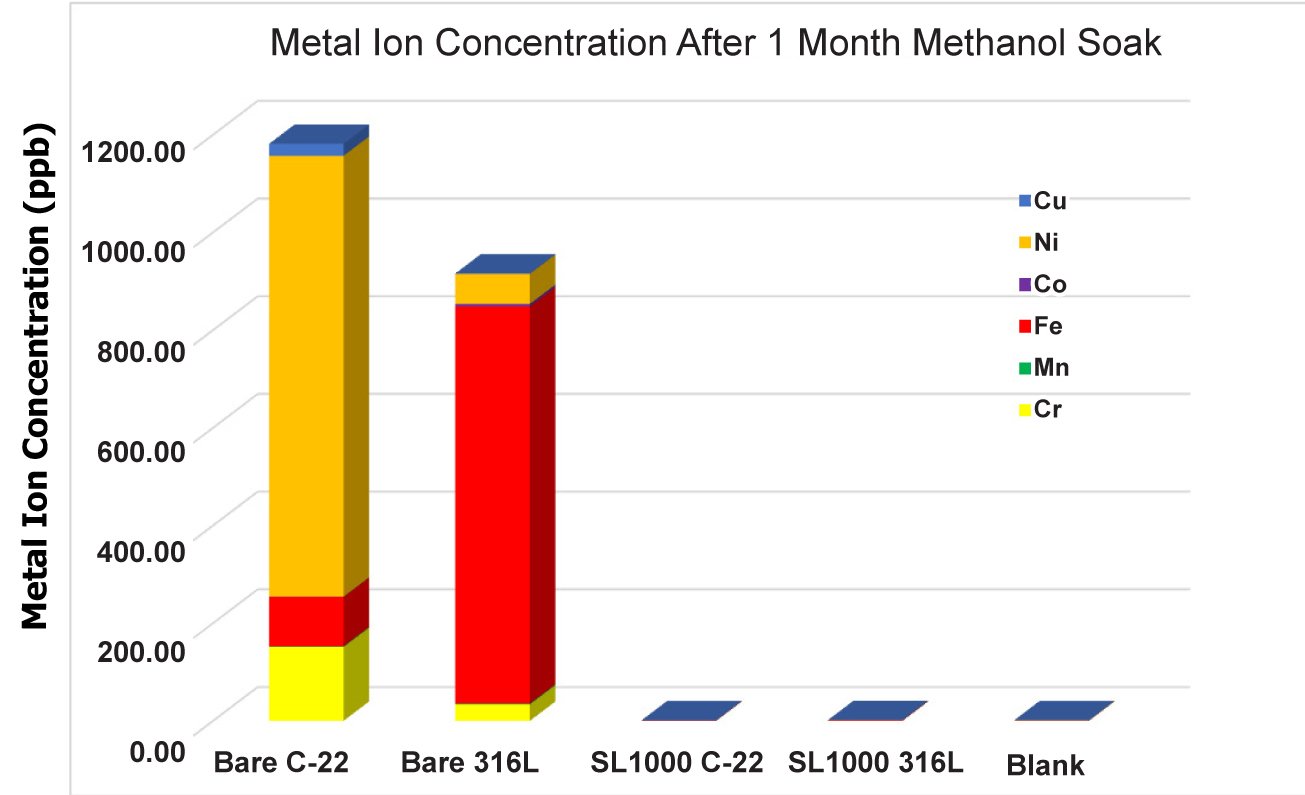 |
After soaking in methanol for 30 days, the C-22 sample measured over 1000 ppb of harmful metal contamination. SilcoTek’s Silcolloy® coating eliminated over 99% of contamination, providing better corrosion protection on Hastelloy® C-22 and even 316L stainless steel (SS). The most effective surface for preventing metal contamination is Silcolloy-coated C-22, ~1.20 ppb metal contamination.
This is an enlarged version of the above graph, showing the samples with the lowest metal contamination. Silcolloy-coated C-22 slightly outperforms a Silcolloy coated 316L stainless steel coupon. Values of coated samples are within errors of measurement.
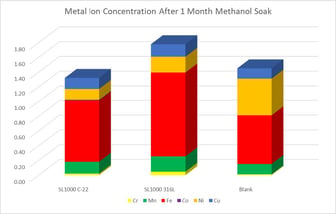
A Pure Layer
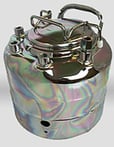 The SilcoTek process produces a chemically pure layer that improves compatibility between your equipment and process stream. SilcoTek silicon CVD coatings are 99.98% pure. That means your process or analytical stream won't be contaminated by metals as a result of corrosion or metal ion leaching. We tested our coating for common metal contaminants. The table below highlights the results. The silicon coating shows only trace metals in the bulk of the coating.
The SilcoTek process produces a chemically pure layer that improves compatibility between your equipment and process stream. SilcoTek silicon CVD coatings are 99.98% pure. That means your process or analytical stream won't be contaminated by metals as a result of corrosion or metal ion leaching. We tested our coating for common metal contaminants. The table below highlights the results. The silicon coating shows only trace metals in the bulk of the coating.
| Element |
Amount Detected |
| Aluminum |
<20 ppm |
| Chromium |
0 ppm |
| Iron |
<100 ppm |
| Nickel |
<10 ppm |
CORROSION RESISTANT
Corrosion can be another source of product contamination. If critical flow paths corrode, the resulting particulates, iron or nickel contamination can damage processes, cause yield failures, corrupt test results and cause significant replacement and maintenance costs. Here again, SilcoTek coatings like Dursan® and Silcolloy® can improve corrosion resistance and reduce contamination.
In this example we used electrochemical impedance spectroscopy (EIS) techniques to determine the effectiveness of our coatings in preventing corrosion breakthrough and pinholes. EIS is a largely non-destructive tool to study and evaluate the performance of protective coatings on metal substrates. A good barrier coating usually displays excellent linearity of increasing impedance vs. deceasing frequency. The higher the impedance value, the more resistance by the coating to the solution permeation into the substrate.
The SilcoTek® coating process produces a continuous, pinhole-free corrosion barrier to aggressive acidic conditions.
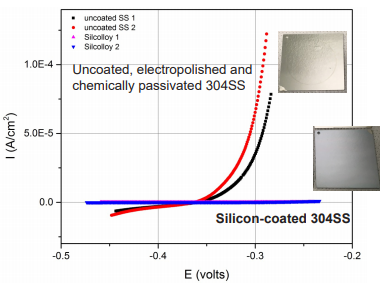
Hydrobromic acid or hydrogen bromide (HBr) is commonly used in polysilicon etch applications and plasma etching. It's an excellent etch compound but unfortunately it will also cause stainless steel corrosion in delivery systems which can result in yield robbing ion contamination and increased maintenance cost. ASTM G31 immersion testing (below) shows how Silcolloy improves corrosion resistance of 316 stainless steel. Corrosion resistance is improved by 6x.
/ASTM%20G31%20Silcolloy%20%206N%20HBr.png?width=434&name=ASTM%20G31%20Silcolloy%20%206N%20HBr.png)
Preventing HBr corrosion can lead to the use of costly super alloys, but an alternative analytical and semiconductor approved material is available. Silcolloy® and Dursan® silicon barrier coatings bonded to stainless steel flow paths offer the best of both worlds. A durable and corrosion resistant surface and an inexpensive, workable stainless steel substrate. In fact SilcoTek coatings, applied by CVD, can be bonded to existing components, no matter how intricate, and still maintain precision tolerances.

Visual inspection of the test coupons after immersion testing tells the story. The uncoated stainless steel coupon shows moderate corrosion while the Dursan and Silcolloy coupons maintain their bright appearance, helping to prevent stainless steel corrosion.
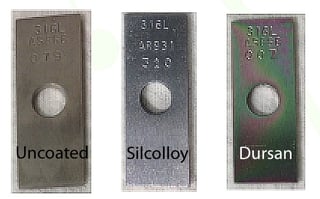
PROTECTIVE LAYER
The SilcoTek® process creates a barrier layer protecting your parts from corrosion and metal ion leaching. Metal concentration in methanol after testing shows only trace metal contaminants, orders of magnitude less than uncoated stainless steel.
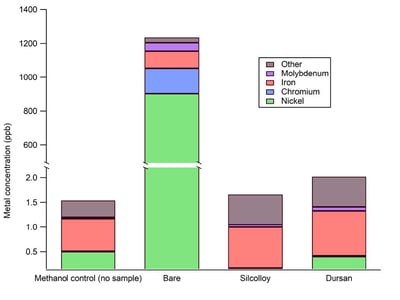 UNIFORM
UNIFORM
The SilcoTek process produces a uniform, inert, amorphous silicon surface. The TEM EDS image below shows a cross section of the coating (red) applied to the substrate surface (blue). The profile shows a uniform silicon layer which will minimize disruption to flow path surfaces.
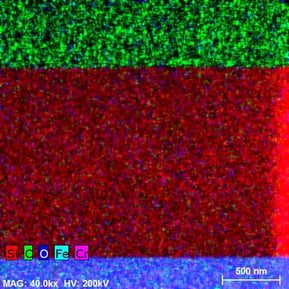
To learn more about how SilcoTek coatings can improve the purity of your analytical system or process chat with a Technical Service Representative, email us, or subscribe to our blog. You can stay in touch with the latest in coating technology by following us on LinkedIn.







/ASTM%20G31%20Silcolloy%20%206N%20HBr.png?width=434&name=ASTM%20G31%20Silcolloy%20%206N%20HBr.png)


 UNIFORM
UNIFORM

